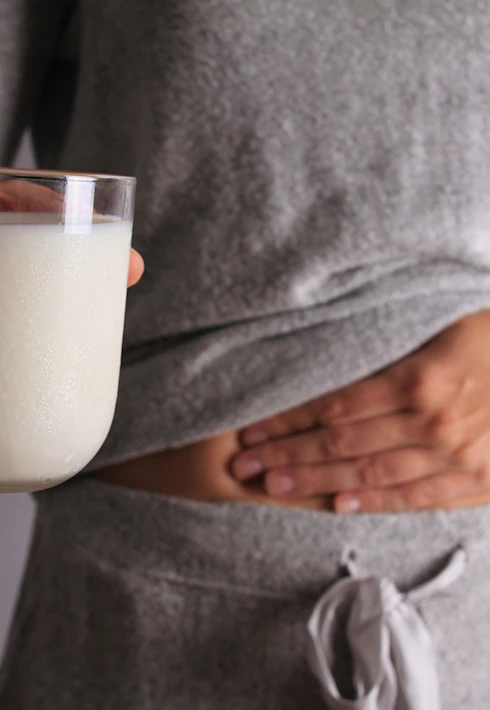Time to read: 5 min
Lactose intolerance: what are the symptoms?
Lactose intolerance is common worldwide, and it is estimated that more than three-quarters of the world's population develop it later in life. If you suffer from lactose intolerance, it can cause a lot of unpleasant symptoms.
In this article, we explain what lactose is, how you can become intolerant to it, and what the symptoms and consequences of lactose intolerance are.
What is lactose?
Lactose is the sugar that occurs in milk and is therefore also called milk sugar. It is a form of carbohydrates (disaccharide) that consists of two simple sugars (galactose and glucose) that can be absorbed by our body.
Lactose is mainly found in dairy products such as cow's milk, sheep's milk, goat's milk, soft cheeses, spreadable cheese, custard, yogurt, quark, and is also present in whey protein and other products that contain milk components or milk powder. Lactose is also often used in medicines and supplements.
What is lactose intolerance?
To break down lactose into glucose and galactose, your body needs lactase. Lactase is an enzyme produced by your intestines and is responsible for digesting lactose and allowing it to be absorbed by your body.
However, when your intestines do not produce enough lactase and cannot digest lactose properly, you can experience symptoms. This is called lactose intolerance and can cause stomach problems and intestinal complaints, as well as skin complaints.
Lactose intolerance is different from a milk allergy. In a milk allergy, there is an allergic reaction of the body to the (casein) proteins in milk. The symptoms that arise are not the result of lactose intolerance but rather an (overly sensitive) reaction of the immune system.
What causes lactose intolerance?
The amount of lactose your body can digest depends on the amount of lactase produced by your intestines. Most people are born with the ability to digest lactose since it is also present in breast milk, which is the primary source of nutrition for newborn babies.
However, starting from around age three, lactase production in our intestines gradually decreases, and as we age, about 80% of the world's population loses the ability to digest lactose.
Lactose intolerance is most prevalent in African and Asian countries. In Europe and North America, this percentage is much lower. It is estimated that about 1 to 2 million people in the Netherlands have lactose intolerance.
What are the symptoms of lactose intolerance?
When your body doesn't produce enough lactase (lactase deficiency) and cannot absorb lactose properly (lactose malabsorption), this can lead to symptoms.
Common symptoms of lactose intolerance include nausea, skin rash, bloating, abdominal pain, flatulence, and diarrhea.
What should you keep in mind with lactose intolerance?
If you experience symptoms after consuming dairy or lactose-containing products, it's better to limit your lactose intake. Even if you don't have obvious symptoms, it's a good idea to experiment and see how you feel after a few weeks of consuming less or no lactose.
While it's not necessary to consume dairy products if you eat a healthy and varied diet, milk and dairy products are a good source of protein and calcium. If you want to avoid dairy products due to lactose intolerance, it's important to get these nutrients from other sources.
You can easily get protein from various plant-based sources such as pea protein, quinoa, lactose-free protein shakes, hemp seeds, chia, nuts and seeds, or a lactose-free meal replacement shake.
The best plant-based sources of calcium include dried figs, sesame seeds, almonds, leafy greens, beans, tofu, tempeh, and most plant-based milk alternatives are often enriched with extra calcium.
Conclusion
Lactose is a form of sugar found in milk and dairy products and is often used in foods and supplements such as whey and casein.
If you experience symptoms after consuming dairy or lactose-containing products, it's likely that your body can no longer digest it properly. In this case, it's best to limit the amount of lactose in your diet or choose a lactose-free alternative.
Our protein shakes, breakfast shakes, and weight loss shakes are all plant-based, lactose-free, and an easy way to get important nutrients.
